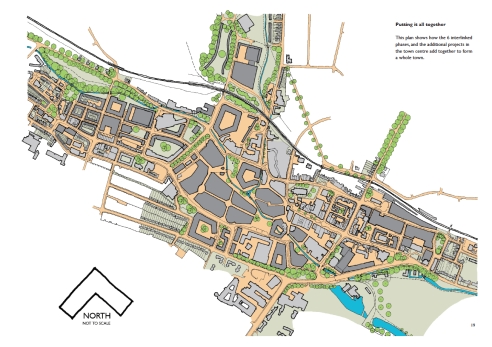Our New Eden
Books, it seems, can change the world … or at least help shape it.
The River Wye – a chalk-stream in Buckinghamshire – was buried under a road in 1965. Since then the town it once flowed through, the town it created, has mourned the river’s absence, while car parks and fly-overs accreted above the underground stream. Finally, in an attempt to revive the town centre, a shopping centre was added to the pile and it was called Eden – though the river that could have watered Eden was still lost.
I wrote a book – Silt Road – about the history of this lost river and on the final page I quoted John Scruton, who over forty years ago formed a society dedicated to bringing back the river. If it is ever possible to bring the river back to the surface of the town, he wrote, then that heart will come back too. John did not live to his see dream come true, and who knows, we (if you share it) may not either. But there is hope again …
In December a member of the projects department of the Town Council, someone who had read my book, wrote me a letter in which he explained the reasons why it has long proved so difficult, impossible almost, to unearth the river. Those reasons are, as I described in Silt Road, that the buried river is too deep underground and that there is too much stuff on top of it. I wrote back and we began a discussion about history. Silt Road was about nothing if not history, how tiers of history shape our landscape and how our landscape shapes us – those “threads of dependence”.
The reasons for not unearthing the River Wye through the town are not really good reasons, I wrote, once you get your head around the history. Basically the river is ‘too deep’ because it is not the original course of the river that is buried, but the course of the mill-leats – which were of course diversions along the sides of the flood-plain. If Roman and Saxon water engineers managed to move the river to the side of the flood-plain in order to drive mills, I suggested, then 21st century engineers can move it back again or to wherever it needs to go in order to have sky above it, not pavement. This was enough to catalyse a feasibility study by engineers who have now agreed a plan of this sort would be possible.
Silt Road cannot claim all the credit. These hopes and plans to unearth the river have existed from time to time and a lot of passionate people have worked hard on them. But like the river they surface and go underground. Again and again. With Silt Road I hope I managed to shine a spotlight on their repeated disappearance and to show also what the town is missing.
But I never realised, until just a few days ago, that these plans had ever amounted to more than a token unearthing of a few hundred yards.
Copied below is a PDF that had gathered metaphorical dust on the hard-drive of the planning department, but which is essentially the same idea as my suggestion: that it is possible to give the river a new course. Here we have both the River Wye and its tributary the Hughenden stream flowing open to the sky and through the centre of the town.
There will be a meeting in the near future to canvas support for the idea. I’ve been asked to talk at the meeting and I’m looking forward to it. If John Scruton were here now I believe he would be to.



5 Responses to “Our New Eden”
Charles,
I hope it happens. I worked at the University for twelve years and it used to break my heart to see some of the wonderful trout in that concrete mess.
Best wishes,
John
[…] at the Kingsnorth power station. Charles Rangeley-Wilson’s subtle book Silt Road (2013) was read by a council officer in High Wycombe and has energised plans to de-culvert the River Wye in the town: what a joyous, unforeseeable […]
In 2013 I bought a cottage on Wycombe Marsh….Front door is 5 metres from The Wye River bank. I was SO transfixed by the beauty of the surroundings when I viewed the cottage …… particularly the River itself…..that I was completely DEAF to the noise of the A40!
Reading ‘ Silt Road’ was an eye-opener and the story continues to haunt me.If only the beautiful Wye COULD be released from it’s prison!
Thanks Jo. Let’s keep burning the candle for the Wye. The council has promised to exhume it, but right now it’s still underground from Westbourne Street to St Mary Street.
[…] at the Kingsnorth power station. Charles Rangeley-Wilson’s subtle book Silt Road (2013) was read by a council officer in High Wycombe and has energised plans to de-culvert the River Wye in the town: what a joyous, unforeseeable […]